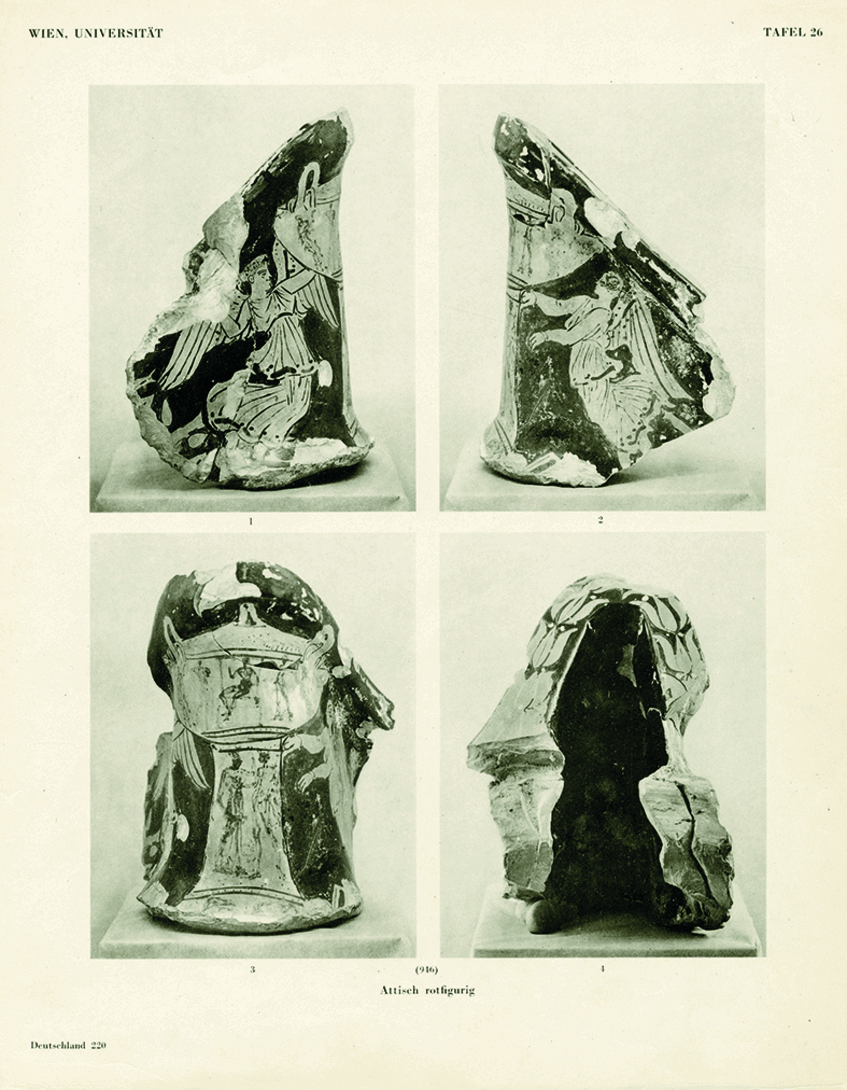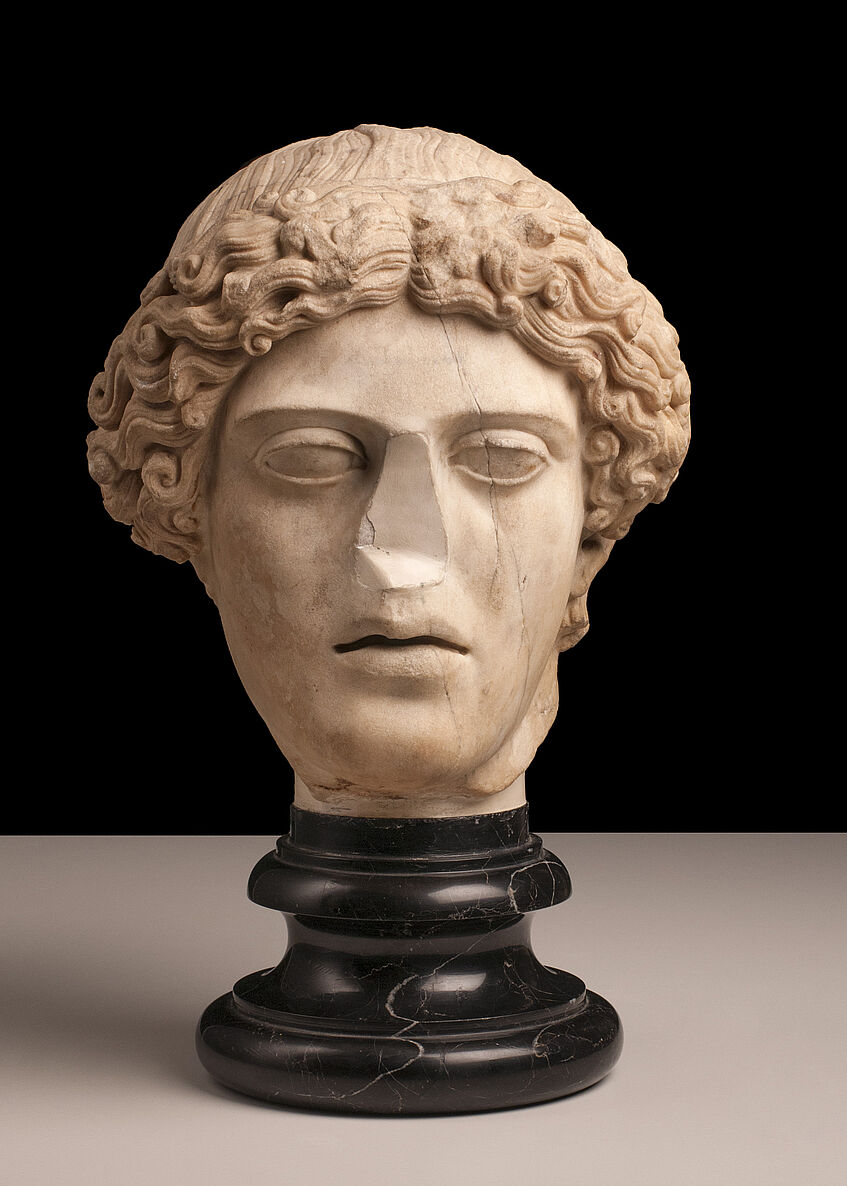
Drawers with metal finds [IKA, photo: Kristina Klein]

Amphorae attributed to Oltos (left, no. 631a) and the Dikaios Painter (right, 631b) [IKA, photo: Kristina Klein]

Eye-cup (no. 1217) [IKA, photo: Kristina Klein]

Spout (no. 946) published in the 1942 CVA volume [CVA Vienna, University 1 pl. 26]

Head of Apollon (no. 412) [IKA, photo: Kristina Klein]
Collection of Original Antiquities
Much later than plaster casts, original antiquities entered the Archaeological Collection. The first items were 66 fragments of Attic pottery and glass objects that were donated to the Archaeological-Epigraphic Seminar in 1878 by Emanuel Stöckler, at the time, the court painter at St. Petersburg. With the relocation to the new university building on the Ring, the collection of originals was successively expanded. A significant assemblage of over 90 objects, mostly ceramics, is owed to Otto Benndorf himself, who obtained the pieces mainly from the Etruscan cities of Vulci and Orvieto and donated them to the collection in 1888. In the following decades, the collection of antiquities continued to grow, mainly due to donations from Austrian nobility, students, graduates or professors at Vienna University, rather than through systematic purchases.
Today, the collection of originals comprises around 4,100 objects, mainly pottery. The items provide an overview of ancient ceramic production, vessel forms and Greek vase painting, and cover a wide range of heterogeneous material, rather than representing museum-quality showpieces. In the collection, the items are arranged chronologically, starting with pottery from the Bronze Age Aegean and Early Iron Age–Geometric Greece. The Archaic period is represented by pottery from various landscapes, such as Etruria (especially Bucchero), as well as black-figure productions from Boeotia, Corinth and the Eastern Aegean. Attic pottery makes up a large part of the collection: Black-figure pieces account for 115 vessels and vessel fragments, red-figure ones for more than 500 items. Furthermore, the collection holds Italic vessels, but also black-gloss ware and Hellenistic and Roman pottery, mainly terra sigillata. Larger parts of the collection were published by Hedwig Kenner in the 1942 volume of the “Corpus Vasorum Antiquorum” (CVA). Hadwiga Schörner is currently preparing a new CVA volume in which all vessels and fragments of the Geometric and Archaic periods will be presented (2021–24).
Among the most interesting Attic black-figure vases in the collection are an Olpe by the Gorgo Painter (no. 1219) with the characteristic depiction of a lion striding to the right, which is currently being restored and reassembled from many fragments; a pinax fragment (no. 1142), i.e. a votive tablet with a dedicatory inscription and the representation of Athena Promachos, which was found on the Athenian Acropolis; as well as an eye-cup (no. 1217) with Dionysos and the satyrs, underlining its use as a drinking vessel for wine.
As for the Attic red-figure vases, two large Late Archaic amphorae stand out, which were acquired by Otto Benndorf in Orvieto in 1891: Dated around 500 and attributed to Oltos, the first amphora (no. 631a) shows Herakles carrying the Kerynite hind under his arm and being pursued by Apollon, with the goddesses Athena and Artemis flanking the scene; the other side of the vase depicts Ares and Aphrodite. The second amphora (no. 631b), attributed to the Dikaios Painter, also belongs to the formative phase of red-figure vase painting, and its main side shows Apollon with his cithara and being accompanied by his sister Artemis and his mother Leto.
Another prominent vase is a large, albeit fragmentary, calyx-crater decorated by the High Classical vase painter Polygnotos, which Otto Benndorf purchased from Vulci. The two registers, arranged one above the other, show three interrelated scenes from the conquest of Troy: In the lower register, Achilleus mourns over his fallen friend Patroklos on one side and is probably approached by the aged Trojan king Priamos on the other, who wants to ransom the body of his son Hector. In the upper zone, the Nereids ride across the sea to provide Achilleus with new weapons. Remarkable red-figure vases in the collection also include a lekythos by the Oedipus Painter (no. 526.a), on which a delicately drawn Eros with a salpinx blows to battle – a very rare depiction –, and the spout of a cauldron-shaped vessel (no. 946), on which a similar cauldron with figural decoration is depicted.
In addition to pottery, the collection of originals includes a rich stock of ancient lamps and glass objects, but also terracotta figurines and small finds made of bronze and other metals. Stone sculpture is represented by an outstanding head of Apollon of the Kassel type (no. 412), which ranks among the Roman Imperial copies of this Classical bronze work and was purchased from the collection of Viennese painter Daniel Penther in 1887.
